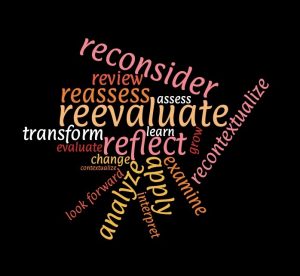Chapter 4: What is Reflection?
Experiential and community-engaged learning put students in the position to develop and practice new skills and confront learners with new perspectives. This challenges learners to develop new perspectives on content taught in class but also more deeply on how they learn and what that means for their lives and professions. Through experiential and community-engaged learning, learners extend their knowledge and conceptual understanding to a new environment or hands-on activity. This extension can bring about a shift in perspective – an aha! moment – where the learner sees things in a more sophisticated, nuanced manner than before.
These kinds of learning cannot be captured by a multiple choice test. Instead, courses that use experiential and community-engaged learning rely on reflection models and assessments to help trace growth and the learner’s journey through their experiences.

A reflection asks you to think critically, assess and analyze, recontextualize and apply your learning to an experience. These types of assessments encourage the learner to go beyond a surface reporting or emotional response, to learn and grow from your experience.
How do I start a reflection?
Writing a reflection might be a new skill for you. It is not the same as a report or essay. The end goal is to think critically: review, assess, and process your experience.
It is best to identify a key issue or incident for the focus of your reflection. This will allow you to organize your thoughts and work toward a critical assessment of your experience.It is best to identify a key issue or incident for the focus of your reflection. This will allow you to organize your thoughts and work toward a critical assessment of your experience. It helps to choose something that bothered you or something you struggled with instead of something that went well so that you can work through your challenges and manage your discomfort.
Learning happens by making mistakes or by confronting your beliefs and actions. It is not always easy, but it takes courage and will lead you will grow in positive ways.
How do I discuss my experience?
A framework helps you consider all sides of the experience and prompts you to move into a thoughtful assessment and application of your learning. In the next chapter, you will see some Reflection Models. Use the one recommended or required by your instructor, and, if you weren’t assigned one, then see the examples in that section.
Remember to think critically and look for ways to apply your course content to your analysis of the experience.
How do I reflect on a critical moment or incident?
It is okay to start the process by acknowledging your emotional response or your confusion and uncertain thoughts about the experience.
After that, consider:
- The learning opportunities that this experience offers to you. How can you push yourself to think about how you can grow from it?
- The questions you have as a result of this experience. Is it making you reassess your thoughts or actions? Reinforcing your course or program learning? Do you need to find out more information or seek a mentor or peer to discuss the experience further?
- Your immediate response and your later reactions. How are they different? How and why did they change?
- The connections you can make to course content and other experiences you have had. How and why did this incident make you see things differently?
How do you apply your class readings or concepts?
You may find yourself looking backward at earlier readings, or later readings might help you understand a previous experience.Your instructors expect you to make the connections between your in-class learning and your experiential learning in the community. Identifying a key concept or passage from your readings and relating it to your critical incident is an effective way to demonstrate these connections. In your reflection — or your planning before your write it — draw connections, elaborate on details, and develop your analysis by referring to course content.
You may find yourself looking backward at earlier readings, or later readings might help you understand a previous experience. Experiential learning and community-engaged learning are often cyclical processes rather than linear ones, and that’s okay!
What do you do at the end of your reflection?
At the end of your reflection, it is customary to look forward and consider how your experience will change your thinking and actions in future experiences.
Reflect on questions such as:
- How did you demonstrate your learning by using concrete details and examples?
- What has changed for you because of this experience?
- What do you want to learn about further or what questions do you still have?
- How will you take this learning forward?
Experiential learning is not one-and-done. It requires the thoughtful processing of the experience, application of course concepts, and a commitment to learning and growing into the future.

